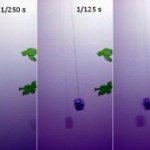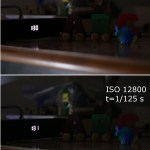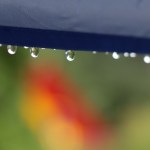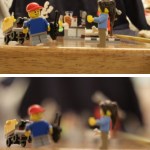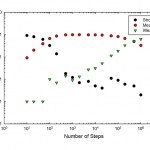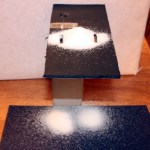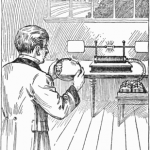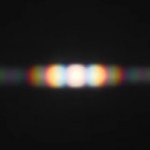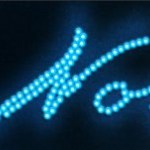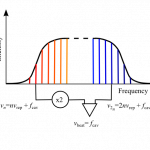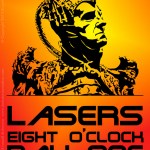Optics
It's been a while since I last rounded up physics posts from Forbes, so there's a good bunch of stuff on this list:
-- How Do Physicists Know What Electrons Are Doing Inside Matter?: An explanation of Angle-Resolved Photo-Electron Spectroscopy (ARPES), one of the major experimental techniques in condensed matter. I'm trying to figure out a way to list "got 1,800 people to read a blog post about ARPES" as one of my professional accomplishments on my CV.
-- The Optics Of Superman's X-Ray Vision: Spinning off a post of Rhett's, a look at why humanoid eyes just aren't set up to work with x-rays…
This one was a whole bunch of work for one smallish shot...
So, in past rounds of "science-y things with my fancy camera," I looked at the effect of ISO settings and apertures. This time out, I wanted to look at something moving, and the way that it blurs with increasing exposure time.
My initial thought was to try to take pictures of a falling ball, but it's too hard to get that to work consistently without setting up some kind of electronic trigger, and I wasn't willing to do that. But, of course, a swinging pendulum will always be in a relatively narrow range of positions, making it a…
A little while back, I did a comparison of the different ISO settings on my camera, and a bunch of people commented that it would be interesting to try to match two photos at different levels. So, here's that:
Trying to match two photos at the extremes of the ISO settings on my camera.
These aren't quite perfectly matched, because the time settings give me a limited range of options, but it's pretty close. The higher ISO setting ought to be 128 times more light-sensitive than then lower, and it's 1/125th of the exposure time.
And... those look pretty similar. I'm honestly not sure how one…
It's a grey, dismal, rainy day here at Chateau Steelypips, and I'm a little groggy from cold medication. Which means it's not a great writing day, but it is a good day to stay inside and do a little SCIENCE! for the photo of the day. thus, this:
Some toys and the cable box in our basement, shot at every ISO setting my camera offers.
This is a small assortment of toys set on the table in our basement next to the cable box, and photographed at every one of the eight ISO settings my camera offers. Everything else is the same in these shots-- I put it on manual focus, the maximum aperture (f/1…
I love a lot of things about our neighborhood, which is all pleasant tree-lined streets and stuff, but it's not a great place for taking pictures of sunset-- I pretty much need to get in the car to get to a place with a clear view of the western horizon. This knocks out a big category of imitation-Scalzi photos, but every now and then there's a cool sunset-related effect, like these clouds last night:
Red patches of cloud at sunset.
This is kind of similar to the sunrise squirrel from a few days ago, but the lit-up clouds are a little more sparse, which makes it more dramatic.
And, of…
For the 42nd installment of this photo-a-day thing, it seems appropriate to try to do some SCIENCE! to get an Answer. So, here's a composite of a bunch of images I took yesterday in order to investigate something:
Graph paper shot with several different lenses, to look for distortion of the images.
OK, this needs some explanation...
So, I do a lot of shooting with moderately wide-angle lenses (either a 10-18mm zoom or the 24mm fixed "pancake" lens), because SteelyKid and The Pip tend to want to be right on top of me a lot of the time, and it's hard to get good pictures with them fully in…
It's rained fairly steadily for the last couple of days, which is to be expected. This also sent me to the back yard in hopes of getting a very particular effect for the photo of the day, that I had seen on a poster from the APS's student photo contest a few years ago:
Water drops on the canopy on our deck, with little inverted images of the back yard.
Here you see a large-aperture shot of drops of water hanging off the edge of the canopy over the patio table on our deck. The drops are in focus, but the rest of the yard is blurred out. If you look closely at the drops, though, you can see…
I've been doing a lot of opining on my blogs of late, and much less science-ing that I would like. So I thought I'd try bringing a little science to the photo-a-day project, by playing around with f-numbers.
I put the camera on the tripod, with my fastest lens (a 50mm f/1.8 prime) and set up an array of SteelyKid's Lego minifigs to be targets. Then I shot pictures of the scene at different aperture settings spanning the full range I could select. The two extremes are shown here:
Lego minifigs shot with the two extremes of my fastest lens. Top is f/22, bottom f/1.8.
I had to put it on…
Last week, I did a post for Forbes on the surprisingly complicated physics of a light bulb. Incandescent light bulbs produce a spectrum that's basically blackbody radiation, but if you think about it, that's kind of amazing given that the atoms making up the filament have quantized states, and can absorb and emit only discrete frequencies of light. The transition from the line spectra characteristic of particular atoms to the broad and smooth spectrum of black-body radiation is kind of amazing.
The way you get from the one to the other is through repeated off-resonant scattering. The…
I was proctoring an exam yesterday in two different sections of the same class, so I had a lot of quite time. Which means I wrote not one but two new posts for Forbes...
The first continues a loose series of posts about the exotic physics behind everyday objects (something I'm toying with as a possible theme for a new book...), looking at the surprisingly complicated physics of an incandescent light bulb. A light bulb filament emits (to a reasonable approximation) black-body radiation, which is historically important as the starting point for quantum physics. But when you think about it, it's…
I'm rooting around in my bag for a pen, and pull out a laser pointer by mistake. Since I'd really prefer not to be grading, I flip it on and shine it on the floor next to the spot where Emmy is half-dozing. She immediately leaps up (she's pretty spry for a dog of 12...), and pounces on it. Or tries to, as I flick the spot across the room.
"Get the dot! Get the dot! Getthedotgetthedotgetthedot!" she mutters as I lead her on a lively chase around the room. After a few minutes, I click the laser off, and put it down. Emmy comes over, panting, and I scratch behind her ears.
"That was fun, eh,…
It didn't make the news, because skittish media types are mostly based in New York City and thus don't care about anything north of Westchester County, but we had a big snow storm yesterday. It started snowing Sunday night, though, and kept up through pretty much dinnertime Monday. Both the local schools and the snow-day day-care program we signed the kids up for were shut down, with good reason- I had to go to campus for my 10:30 am class, and that two-mile drive was pretty nerve-wracking.
Since the kids were home for the day, we did a bit of playing outside, even though the temperatures…
Over at Scientific American's Frontiers for Young Minds blog, they have a great post on what happens when you ask scientists to explain key elements of a different research field. It's pretty funny, and rings very true, as SteelyKid asks me tons of science questions, very few of which have anything to do with atomic, molecular, or optical physics. so I spend a lot of time faking my way through really basic explanations of other fields.
Of course, even pitching stuff from my own field at the right level for small kids is a challenge. Which reminds me, I never did explain my presentation for…
(When I launched the Advent Calendar of Science Stories series back in December, I had a few things in mind, but wasn't sure I'd get through 24 days. In the end, I had more than enough material, and in fact didn't end up using a few of my original ideas. So I'll do a few additional posts, on an occasional basis, to use up a bit more of the leftover bits from Eureka: Discovering Your Inner Scientist...)
One of the things I was reacting against in writing Eureka is the popular idea of scientists as a sort of unworldly elite, off doing their ivory-tower idealized thing without worrying about…
SteelyKid missed the bus this morning-- she was dressed and ready, but I was talking to Kate, and if there isn't a person at the end of the driveway when the bus comes around the corner, they won't stop. So I drove her over to school myself (which is faster, anyway). The GE research lab complex is behind her school, so there's a nice view from the parking lot to the eastern horizon, where the sun was just poking over a big band of clouds.
"Hey, look at that cool sunset!" she said as we were walking from the car to the building.
"That's not a sunset, honey, it's a sunrise. It's morning."
"Oh,…
Scientific controversies aren't always settled by a single dramatic experiment, but it's a lot of fun when they are. It's even more fun when they can be carried out with, as the author put it, "without any other apparatus than is at hand to every one."
I'm speaking in this case of the famous "double slit" experiment of Thomas Young, though if you want to be really picky about it, he didn't originally do it with a double slit, but a single "slip of card" that divided a beam of sunlight. Some distance away from the card, the overlapping light from either side of the card combined to produce a…
I tooke a bodkine gh & put it betwixt my eye & [the] bone as neare to [the] backside of my eye as I could: & pressing my eye [with the] end of it (soe as to make [the] curvature a, bcdef in my eye) there appeared severall white darke & coloured circles r, s, t, &c. Which circles were plainest when I continued to rub my eye [with the] point of [the] bodkine, but if I held my eye & [the] bodkin still, though I continued to presse my eye [with] it yet [the] circles would grow faint & often disappeare untill I removed [them] by moving my eye or [the] bodkin.
If [the…
The 2014 Nobel Prize in Physics has been awarded to Isamu Akasaki, Hiroshi Amano and Shuji Nakamura for the development of blue LED's. As always, this is kind of fascinating to watch evolve in the social media sphere, because as a genuinely unexpected big science story, journalists don't have pre-written articles based on an early copy of a embargoed paper. Which means absolutely everybody starts out using almost the exact words of the official Nobel press release, because that fills space while they frantically research the subject. Later in the day, you'll get some different framing, once…
On Twitter Sunday morning, the National Society of Black Physicsts account retweeted this:
Using Lasers to Lock Down #Exoplanet Hunting #Space
http://t.co/0TN4DDo7LF
— ✨The Solar System✨ (@The_SolarSystem) September 28, 2014
I recognized the title as a likely reference to the use of optical frequency combs as calibration sources for spectrometry, which is awesome stuff. Unfortunately, the story at that link is less awesome than awful. It goes on at some length about the astronomy, then dispenses with the physics in two short paragraphs of joking references to scare-quoted jargon from the…
I didn't plan to do a follow-up to yesterday's post about the optics of sending messages with lasers, but then I starting idly thinking about detection, prompted in part by a bunch of conversations with my summer students about single-photon detectors. which led to scribbling on the back of an envelope, which led to Googling, and suddenly, I have a follow-up post.
So: as we said yesterday, if you want to send messages over a distance of ten light years, a relatively efficient way to do this might be to send them via lasers. This results in the light being spread over a pretty big area, though…
